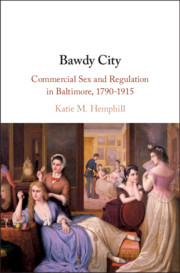Book contents
- Bawdy City
- Bawdy City
- Copyright page
- Dedication
- Contents
- Figures
- Acknowledgments
- Abbreviations
- Introduction
- Part I The Rise of Prostitution in the Early Republic
- Part II Regulating and Policing the Sex Trade
- Part III Change and Decline in the Brothel Trade
- 7 Black Baltimoreans and the Bawdy Trade
- 8 Rise of Urban Leisure and the Decline of Brothels
- 9 The End of an Era
- Conclusion
- Bibliography
- Index
7 - Black Baltimoreans and the Bawdy Trade
from Part III - Change and Decline in the Brothel Trade
Published online by Cambridge University Press: 06 December 2019
- Bawdy City
- Bawdy City
- Copyright page
- Dedication
- Contents
- Figures
- Acknowledgments
- Abbreviations
- Introduction
- Part I The Rise of Prostitution in the Early Republic
- Part II Regulating and Policing the Sex Trade
- Part III Change and Decline in the Brothel Trade
- 7 Black Baltimoreans and the Bawdy Trade
- 8 Rise of Urban Leisure and the Decline of Brothels
- 9 The End of an Era
- Conclusion
- Bibliography
- Index
Summary
This chapter examines black women’s increased participation in the sex trade in the aftermath of the Civil War. During the 1860s, thousands of black women, children, and men arrived in Baltimore as refugees from war and enslavement. As police increasingly pushed brothels out of “respectable” neighborhoods, black Baltimoreans who faced limited housing prospects found themselves occupying the same neighborhoods as sex establishments. As the overlap between brothel districts and black neighborhoods grew, black women entered the indoor sex trade in larger numbers and began to remake it to suit their needs and preferences. Although selling sex was an important part of personal economies of makeshifts for black sex workers, sex work fueled long-standing racial stereotypes about black women’s libidinousness and black men’s unfitness as patriarchs. Middle-class black Baltimoreans who founded the city’s Colored Law and Order League attempted to resist these stereotypes by publicizing their efforts to clean up their neighborhoods, but they failed to sway the city’s white politicians, who used the alleged “disorder” of black residential enclaves to argue for racial segregation of housing.
Keywords
- Type
- Chapter
- Information
- Bawdy CityCommercial Sex and Regulation in Baltimore, 1790–1915, pp. 199 - 227Publisher: Cambridge University PressPrint publication year: 2020



